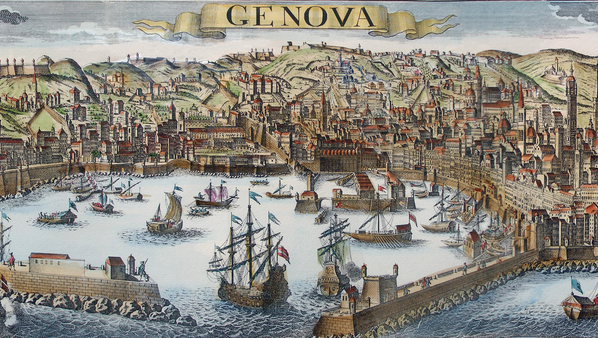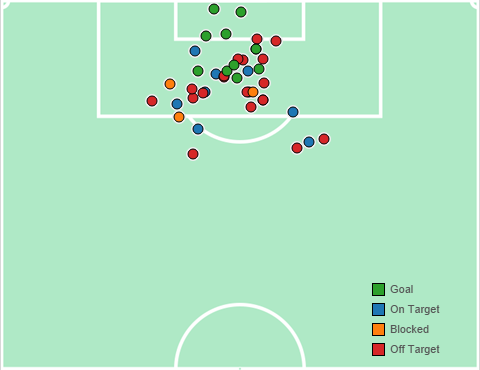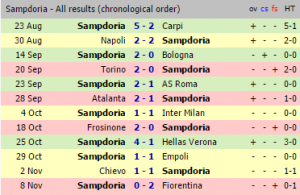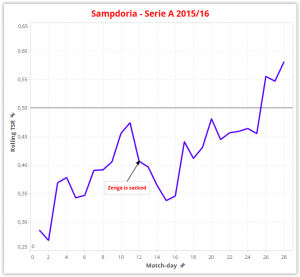 From 1096 to 1797 the Republic of Genoa was one of the most powerful city-states in Italy and Europe. Alongside Venice, Pisa and Amalfi, it was one of the Maritime Republics, independent entities provided with a fleet of ships both for their own protection and to support their rich and extensive trade networks all over the Mediterranean Sea. During the 16th century Genoa flourished under the government of the admiral Andrea Doria (one of the two teams which in 1946 merged to form Sampdoria was named after him) but after reaching its peak the Republic fell in 1797, when Napoleone Bonaparte established the Ligurian Republic. In the 2014/2015 football season the region flourished much like it had in the 16th century: Genoa finished sixth on the table, with three points more than city rivals Sampdoria, who placed 7th but still qualified for the Europa League play-offs at the expense of the Rossoblu, who were denied a UEFA licence by the FIGC. Both Genoese teams outdid AC Milan and Inter Milan in the league table. Less than a year after, we find both teams nowhere near the same level of performance, much less results: Genoa and Sampdoria are experiencing far lesser seasons with both teams collecting just 31 points from 28 matches, and even though they both won last weekend, they are still fighting to avoid relegation. Genoa CFC A typical Genoa transfer merry-go-round took place once again during last two transfer windows. Practically every six months the Genoa roster is revolutionised and the only certainty in the Rossoblu dressing room is the manager Gian Piero Gasperini, at the helm since September 2013, after a previous spell lasted from 2006 to 2010, in which his devoted 3-4-3 brought Genoa back to the Italian top tier. Last season's 6th place was the second best result of Gasperini’s managerial career as well as Genoa second best placement since they came back to Serie A (in 2008-2009 with Thiago Motta and Diego Milito at their disposal the Grifo clinched 5th spot). Seven out of the eleven players with the most minutes played last season are no longer part of the squad, including top scorer Iago Falqué (13 goals, 5 assists) and Diego Perotti (3.8 dribbles & 2.1 key passes per 90 last season, 4.7 dribbles & 2.8 key passes p90 this term prior to January). Both eventually found themselves sold to AS Roma and also departing was Andrea Bertolacci whose contribution to the cause consisted of 8 goals and 5 assists before being acquired by AC Milan for a reported fee of €20 million (the Rossoblu got just €8.5 million from the sale, since the midfielder was in co-ownership with Roma). Genoa ended the 2014/2015 championship with the 6th best attack (62 goals scored) and the 8th best defence (47 goals conceded), but their underlying numbers weren’t exceptionally good.
From 1096 to 1797 the Republic of Genoa was one of the most powerful city-states in Italy and Europe. Alongside Venice, Pisa and Amalfi, it was one of the Maritime Republics, independent entities provided with a fleet of ships both for their own protection and to support their rich and extensive trade networks all over the Mediterranean Sea. During the 16th century Genoa flourished under the government of the admiral Andrea Doria (one of the two teams which in 1946 merged to form Sampdoria was named after him) but after reaching its peak the Republic fell in 1797, when Napoleone Bonaparte established the Ligurian Republic. In the 2014/2015 football season the region flourished much like it had in the 16th century: Genoa finished sixth on the table, with three points more than city rivals Sampdoria, who placed 7th but still qualified for the Europa League play-offs at the expense of the Rossoblu, who were denied a UEFA licence by the FIGC. Both Genoese teams outdid AC Milan and Inter Milan in the league table. Less than a year after, we find both teams nowhere near the same level of performance, much less results: Genoa and Sampdoria are experiencing far lesser seasons with both teams collecting just 31 points from 28 matches, and even though they both won last weekend, they are still fighting to avoid relegation. Genoa CFC A typical Genoa transfer merry-go-round took place once again during last two transfer windows. Practically every six months the Genoa roster is revolutionised and the only certainty in the Rossoblu dressing room is the manager Gian Piero Gasperini, at the helm since September 2013, after a previous spell lasted from 2006 to 2010, in which his devoted 3-4-3 brought Genoa back to the Italian top tier. Last season's 6th place was the second best result of Gasperini’s managerial career as well as Genoa second best placement since they came back to Serie A (in 2008-2009 with Thiago Motta and Diego Milito at their disposal the Grifo clinched 5th spot). Seven out of the eleven players with the most minutes played last season are no longer part of the squad, including top scorer Iago Falqué (13 goals, 5 assists) and Diego Perotti (3.8 dribbles & 2.1 key passes per 90 last season, 4.7 dribbles & 2.8 key passes p90 this term prior to January). Both eventually found themselves sold to AS Roma and also departing was Andrea Bertolacci whose contribution to the cause consisted of 8 goals and 5 assists before being acquired by AC Milan for a reported fee of €20 million (the Rossoblu got just €8.5 million from the sale, since the midfielder was in co-ownership with Roma). Genoa ended the 2014/2015 championship with the 6th best attack (62 goals scored) and the 8th best defence (47 goals conceded), but their underlying numbers weren’t exceptionally good.  In 14/15 they had only the 11th most shots (12.9 per game), while conceding the 9th least shots (13.1 per game). Both of their shot ratios were beneath the 50% mark, while an above average conversion rate (12.7%) and an all shot PDO of 1032 reinforced the hypothesis they collected some sort of debt with Lady Luck. This season things have quickly turned ugly for Gasperini and his team. Practically, Genoa got worse in every offensive stat I looked at. A slightly improved rate of saving all shots, hasn’t been enough to compensate for their attacking deterioration. Shots taken have fallen around a unit to 12.0 per game, while their shots conceded practically remained the same. None of these underlying stats declines are critical in themselves but the positive variance which sustained Genoa's run to the 6th place last term has vanished completely. Indeed the Grifo suffered a huge – 4.37% drop in their conversion rate, which is now under league average at just 8.33%. Genoa not only lost 49 of the 62 goals scored last season in the last two transfer windows, but have also missed their main goal-scoring outlet, Leonardo Pavoletti, for a large portion of this season, since the ex-Sassuolo striker has played just 1300 out of the 2520 minutes available and he’s now once again out injured. When fit he has been incredible for Genoa, scoring 0.69 non-penalty goals per 90 or if you prefer, 10 of the 28 goals of the Rossoblu. Not only Pavoletti is very strong in the air as his 4 headed-goals can confirm (he wins 5.5 aerial duels per 90, 54% of the total), but he also showed a natural predilection for the Danger Zone in his shot-selection, which definitely propelled his goal-scoring tally.
In 14/15 they had only the 11th most shots (12.9 per game), while conceding the 9th least shots (13.1 per game). Both of their shot ratios were beneath the 50% mark, while an above average conversion rate (12.7%) and an all shot PDO of 1032 reinforced the hypothesis they collected some sort of debt with Lady Luck. This season things have quickly turned ugly for Gasperini and his team. Practically, Genoa got worse in every offensive stat I looked at. A slightly improved rate of saving all shots, hasn’t been enough to compensate for their attacking deterioration. Shots taken have fallen around a unit to 12.0 per game, while their shots conceded practically remained the same. None of these underlying stats declines are critical in themselves but the positive variance which sustained Genoa's run to the 6th place last term has vanished completely. Indeed the Grifo suffered a huge – 4.37% drop in their conversion rate, which is now under league average at just 8.33%. Genoa not only lost 49 of the 62 goals scored last season in the last two transfer windows, but have also missed their main goal-scoring outlet, Leonardo Pavoletti, for a large portion of this season, since the ex-Sassuolo striker has played just 1300 out of the 2520 minutes available and he’s now once again out injured. When fit he has been incredible for Genoa, scoring 0.69 non-penalty goals per 90 or if you prefer, 10 of the 28 goals of the Rossoblu. Not only Pavoletti is very strong in the air as his 4 headed-goals can confirm (he wins 5.5 aerial duels per 90, 54% of the total), but he also showed a natural predilection for the Danger Zone in his shot-selection, which definitely propelled his goal-scoring tally. 

 Taken overall Sampdoria have become obviously worse than last season and are comparatively worse than Genoa. It’s true that they improved their scoring production to 1.50 goals per game, but that seemed likely to be because of variance, by way of a seasonal conversion rate a shade under 13%, rather than skill.
Taken overall Sampdoria have become obviously worse than last season and are comparatively worse than Genoa. It’s true that they improved their scoring production to 1.50 goals per game, but that seemed likely to be because of variance, by way of a seasonal conversion rate a shade under 13%, rather than skill.  Oddly their all shot PDO is more or less the same as last season (1022), when their main strength was Mihajlović efficient defensive system, as their above average 2014/15 all shot save rate (91.91% ) confirmed. Recently with two crucial wins in a row against two relegation candidates, Frosinone and Verona, Sampdoria eased up some pressure and finally we are seeing Montella harvesting some fruits of his work. In my opinion Sampdoria is on a better level than Genoa in term of personnel, and unless we see a miracle from Frosinone, will stay in Serie A with their rivals. Sampdoria's bad underlying numbers reflect Zenga’s substandard managing–he has hardly gone on to success elsewhere, recently resigning from his new job as Al Shaab manager after losing nine games out of 11– and the delicate process of learning of Montella ambitious style is only slowly impacting. Sampdoria have paid heavily for their summer gamble (Zenga’s debated appointment) with a disastrous season. Conclusion This Genoese football golden age was just ephemeral and once more the Republic has declined. Genoa and Sampdoria dreamed to reinforce their rare superiority over Milan's teams only to see that fall away after just a handful of games. In less than year both clubs moved from potentially competing in an European competition to fighting to stay in the league. On top of that, both squads lost some of their best players, and given their precarious financial situation, the two clubs will likely proceed with their disinvestment policy, in order to pay their debts. In all fairness, future doesn’t seem bright for Genoese football.
Oddly their all shot PDO is more or less the same as last season (1022), when their main strength was Mihajlović efficient defensive system, as their above average 2014/15 all shot save rate (91.91% ) confirmed. Recently with two crucial wins in a row against two relegation candidates, Frosinone and Verona, Sampdoria eased up some pressure and finally we are seeing Montella harvesting some fruits of his work. In my opinion Sampdoria is on a better level than Genoa in term of personnel, and unless we see a miracle from Frosinone, will stay in Serie A with their rivals. Sampdoria's bad underlying numbers reflect Zenga’s substandard managing–he has hardly gone on to success elsewhere, recently resigning from his new job as Al Shaab manager after losing nine games out of 11– and the delicate process of learning of Montella ambitious style is only slowly impacting. Sampdoria have paid heavily for their summer gamble (Zenga’s debated appointment) with a disastrous season. Conclusion This Genoese football golden age was just ephemeral and once more the Republic has declined. Genoa and Sampdoria dreamed to reinforce their rare superiority over Milan's teams only to see that fall away after just a handful of games. In less than year both clubs moved from potentially competing in an European competition to fighting to stay in the league. On top of that, both squads lost some of their best players, and given their precarious financial situation, the two clubs will likely proceed with their disinvestment policy, in order to pay their debts. In all fairness, future doesn’t seem bright for Genoese football.
2016
The Downfall of Genoa
By admin
|
March 8, 2016